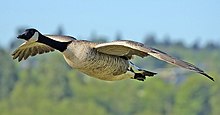Anserini
| Goose Temporal range: Late Miocene-Holocene, 10–0 Ma |
|
|---|---|
 |
|
|
Canada goose, Branta canadensis |
|
| Scientific classification | |
| Kingdom: | Animalia |
| Phylum: | Chordata |
| Class: | Aves |
| Order: | Anseriformes |
| Family: | Anatidae |
| Subfamily: | Anserinae |
| Tribe: | Anserini |
| Genera | |
Geese are waterfowl belonging to the tribe Anserini of the family Anatidae. This tribe comprises the genera Anser (the grey geese), Branta (the black geese) and Chen (the white geese). Some other birds, mostly related to the shelducks, have "goose" as part of their names. More distantly related members of the family Anatidae are swans, most of which are larger than true geese, and ducks, which are smaller.
The word "goose" is a direct descendent of Proto-Indo-European root, *ghans-. In Germanic languages, the root gave Old English gōs with the plural gēs and gandres (becoming Modern English goose, geese, gander, and gosling, respectively), Frisian goes, gies and guoske, New High German Gans, Gänse, and Ganter, and Old Norse gās. This term also gave Lithuanian žąsìs, Irish gé (goose, from Old Irish géiss), Latin anser, Greek χήν/khēn, Dutch gans, Albanian gatë (heron), Sanskrit hamsa and hamsi, Finnish hanhi, Avestan zāō, Polish gęś, Ukrainian гуска and гусак, Russian гусыня and гусь, Czech husa, and Persian ghāz.
...
Wikipedia
